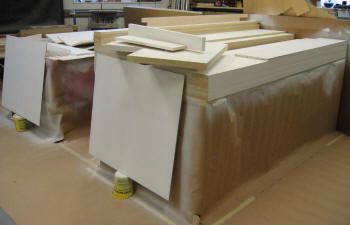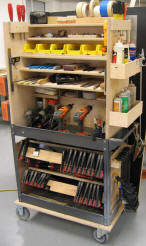How would you like a raise? I knew that would get your attention. Well, I realized a few years ago that there were two basic ways I could make more money doing woodworking, which as we all know is not the easiest way to make a living. I could either charge more for the same product (and then have to work harder to make the sale) or I could figure out how to get more work done in a day. Maybe it’s just laziness, but I am constantly thinking about how I can accomplish the greatest amount of work with the least amount of effort. I’ve identified two areas which seem to have the biggest potential for eliminating wasted effort and streamlining production.
The first involves analyzing the flow of work through the shop and figuring out areas where small changes can save steps or eliminate operations. Here’s an example: My edgebander does a decent job but the end trimmers leave something to be desired; they often chew up the end of the tape or cut it cleanly but not flush to the substrate. I would have to block sand the ends of every part before assembly to clean up after the machine. So it occurred to me that if I edgeband the 8’ long rips before crosscutting the parts to length, the tablesaw would cut the edgetape and the substrate simultaneously. So now not only is every end cut perfectly without my even having to think about it (let alone hand sand each and every one), but it turns out it’s more efficient to handle the 8’ rips instead of keeping track of multiple parts and which edges get banded, etc. So there were additional savings beyond what I had expected.

An entire kitchen worth of cabinet parts stacked up, primed,
and ready for lacquer, lets me finish before I’ve even begun!
But it gets better. I often find that the streamlining is an incremental process, where one improvement leads to another until after a while the entire production method looks little like it did before the process began. For instance, I always finish the banded edges of my frameless cabinets to match the doors, so that any edge that shows through cracks between doors or next to a door blends in. Initially that involved masking every cabinet after assembly, a time consuming job no matter how you do it. Well I noticed that I could finish the edges of the shelves by stacking them up and just finishing the stack of edges, and only have to mask the top shelf in the stack. So I had the breakthrough idea of stacking all the parts and finishing all the edges in a big stack before assembling the cabinets! Maybe some of you have been doing this for years and I’m just a little slow, but for me this was a huge time-saver. No more masking!! I really patted myself on the back for that one. But then I realized that if I was edgebanding the long rips before crosscutting, why not stack up the 8’ rips and prefinish the entire job before crosscutting the parts? Between this change and many others I have reduced the time it takes me to produce a set of cabinets from weeks to days, and increased my bottom line tremendously.

Sign of a sick mind? Maybe, but one which knows where all its tools are. With this wheeled cart, everything I’m likely to need can be rolled over to anywhere in the shop.
The second area worth looking at involves set-up times. I’m talking about the amount of work you have to do before you can actually turn on a machine or pick up a staple gun and start stapling. This might not apply as much in a large production shop where the workflow doesn’t vary from day to day, and each station or machine does the same thing, day in, day out; but in a custom shop we might be building melamine kitchen cabinets one week, a veneered bedroom suite the next, and who knows what after that, all in the same space and with the same equipment. If it takes 15 minutes to clear off the router table before you can put a bit in it you aren’t getting paid for that 15 minutes. So I’m always looking to minimize set-up times, and I’ve found a couple of ways to do that. First of course is to have the shop itself organized to minimize steps and to allow each machine to be used without having to do any re-arranging. That’s pretty basic stuff. But a less obvious step is to stock each machine or area with the tools and materials needed to maintain and operate it efficiently. For instance, my ShopBot is located at one end of my shop, and my assembly area is at the other end. So I constantly found myself walking back and forth across the shop to fetch a sanding block and bench brush to clean the platten off – now the ShopBot has its own sanding block and brush dedicated to that end of the shop. I haven’t bit the bullet and stationed a cordless drill at the ShopBot yet, but that’s a logical next step. I also try to organize each station or area so that tools and supplies are easily accessible, and I can see at a glance if anything is missing or needs to be replenished.
The other method I use to minimize the cost of set-up times is to combine jobs and organize workflow to get as many jobs or as much material through a machine or operation while it’s set up for a particular task. Even though my tablesaw is always ready for cutting, it takes at least a few minutes (or more) to get ready to cut out a large job. I’ll often cut and edgeband parts for any small jobs in the cue at the same time as a larger job, then set those parts aside for later assembly. That way I’ve essentially eliminated the set-up time on those operations for the smaller jobs, on which the set-ups often take as long as the operation itself. It’s the same thing as picking up milk on the way home instead of going back out to get some later.
I think next time I’ll highlight some of the machines I use regularly to keep product going out the door and sawdust in the bin. But this column is here for you so if there’s anything you’d like to see here just let me know.